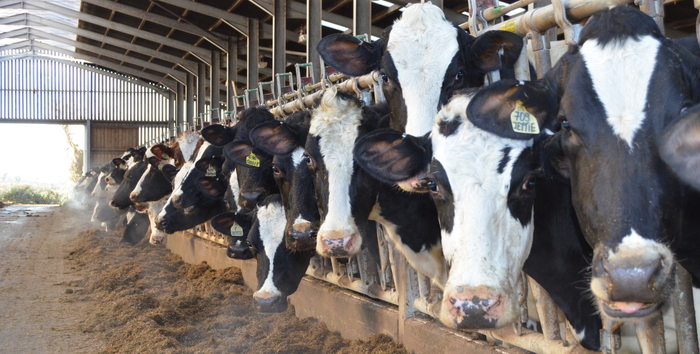Winter dairy diets will need careful balancing to make the most of variable grass silages in the light of considerable price volatility, particularly for protein sources.
“The challenging weather this season means some farmers went early while for other harvest was delayed,” comments Trouw Nutrition, ruminant technical development manager Dr Liz Homer. “These initial results reflect those crops taken early and could be very different from later harvested crops. There is also a considerable range within the crops analysed reflecting different grass growth.”
Dr Homer says the results of the first 500 grass silage samples analysed show fermentation quality is good with moderate pH and lactic acid levels and mostly low sugars. Dry matter has averaged 33.7 % and D value ranges from 58-76%.
While the average ME content is 11.7MJ/kgDM, a significant number of crops have ME levels closer to 10MJ/kgDM. Crude Protein varies from 7.5-22% with an average of 14.6% which reflects low protein levels in pre-cut samples.
“There is a big range in NDF content, from 29-63 %DM. The average of 41%DM is unsurprising given that NDF levels were low for a prolonged period in the early spring. Most samples in these results will have been cut before levels began to rise.”
She says low NDF is reflected in a low fibre index, while acid load is high because of the increased digestibility of the crop. These should be a warning sign for rumen health. While there is less fibre, it is more digestible which will affect fermentation rates. Lower fibre levels mean that Total Fermentable Carbohydrates are lower as well.
“Acid load and fibre index, which are a good indicator of how silages will perform in the rumen, and energy content, are all influenced by dry matter, digestibility and NDF content. We anticipate silages this year will behave very differently in the rumen and will need carefully balancing using more detailed descriptors than just ME.
Dr Homer says rumen health will be fundamentally important and advises farmers to consider fibre sources to promote better rumen function. Soya hulls, sugar beet pulp and straw could all have a role to play. Care should be taken with adding cereals if silage acid load is high.
“Balancing the rumen will give the best chance of maintaining margins next winter. By doing so it will be possible to optimise the supply of microbial protein which is the best and cheapest source of protein for milk production.
“While data on national average silage cuts give an overall impression of forage quality, they always mask a wide variation in actual crops. This year it is likely the difference from farm to farm will be even more pronounced making it vital clamps are analysed regularly and diets fine-tuned accordingly.”
| Nutrients | Units | Minimum | Average 2021 | Maximum |
| Dry Matter | % | 12.97 | 33.72 | 54.52 |
| Crude Protein | % DM | 7.47 | 14.61 | 22.44 |
| D Value | % | 57.75 | 73.18 | 76.08 |
| ME | MJ/kg DM | 9.24 | 11.71 | 12.17 |
| NDF | % DM | 29.02 | 41.78 | 63.13 |
| Lignin | g/kg DM | 14.60 | 35.99 | 60.61 |
| Ash | % DM | 1.40 | 8.21 | 13.73 |
| Fermentation Quality | ||||
| pH | 3.50 | 4.20 | 6.29 | |
| Sugars | % DM | 0.20 | 3.16 | 10.39 |
| Lactic acid | g/kg DM | 2.00 | 83.43 | 180.77 |
| VFA | g/kg DM | 0.58 | 18.03 | 62.14 |
| NH-3 of total N | % DM | 1.14 | 2.71 | 34.15 |
| Acid Load | 32.14 | 52.52 | 68.43 | |
| Fibre Index | 115.88 | 167.14 | 260.09 |


